The Civilization series as a whole seems to stand apart from the modern world of gaming. It is a monolith, a titan. A simple concept brought to life, but with difficult execution. The original Sid Meier’s Civilization is the game that’s credited for hooking adults on video games, proving that flights of digital fancy weren’t just for children jumping on goombas. To many, it is a precious thing that holds a very particular place in their minds, a mixing of nostalgia and lust for world domination.
It’s one of the reasons why when Civilization VI was announced, the reveal was met with a lot of surprise and suspicion; right up front, Firaxis made it clear that the tried and true formula of city building was upended. The art direction appeared to take a dramatic change, and the way you researched both science and government civics were being turned on their head. It takes guts to reinvent the wheel, especially when your game is one of the lofty grandfathers of a genre. Make no mistake, this was a risky move that on one hand, could help revive the series for a whole new set of players, but it could also alienate die-hard fans that had been with the series for decades.
Civilization VI is a game that needs to be played – a lot – in order to be fully understood; it has diplomacy systems, government systems, a way to wage religious war without firing a single shot. With over 20 hours into playing already, we wanted to take a look at all of the changes that have come with this newest title, and break them down as we work towards our full review later this week.
It’s A Brave New World Out There
One of the first things that people will talk about is the art direction. Civilization 5 was lauded for having a lofty, Art Deco direction. From the opening menu to all the various symbols on the HUD, Civ 5 went with an almost regal approach to the fact that you were acting as a god-king to your chosen nation. It made sense.
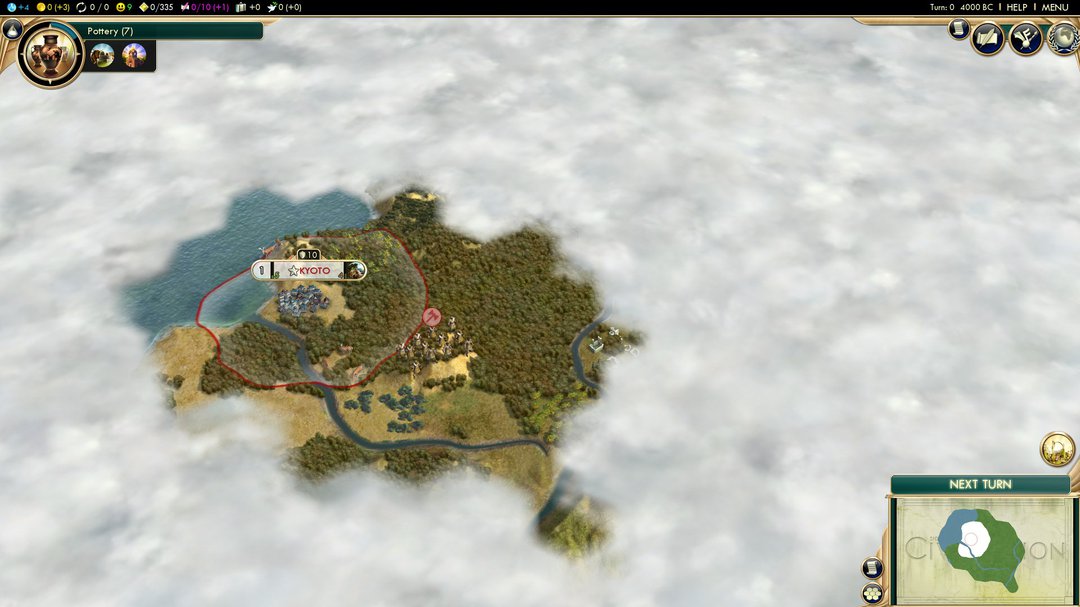
Note the gilded edges to the displays around the screen. This was a great look during the era when Bioshock first came out.
When Civilization VI was announced, it was obvious that they had scrapped this style for something a little different, and a little more… cartoonish.
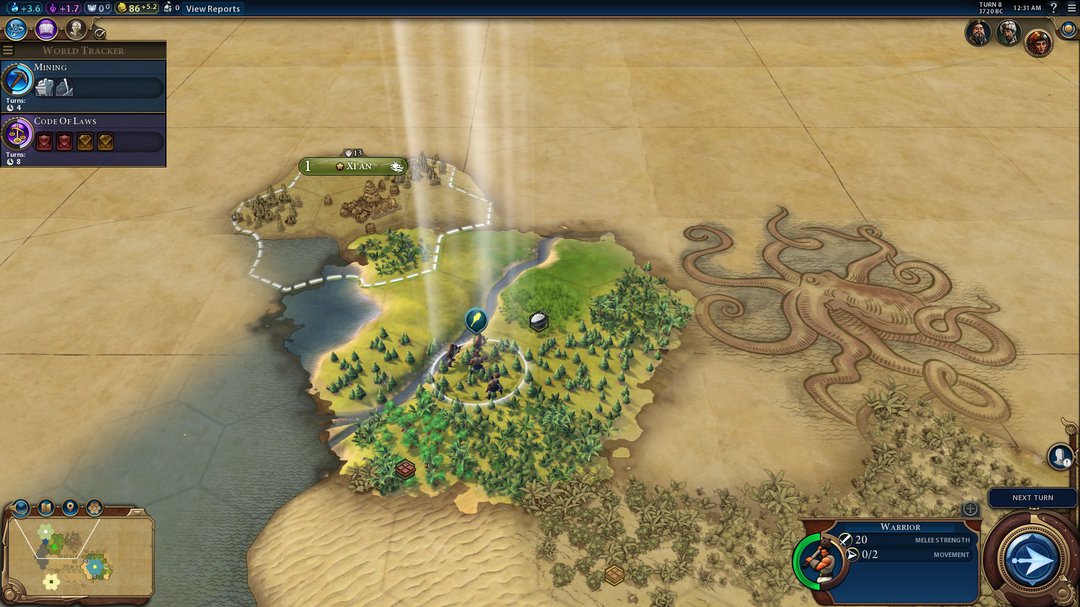
There were more than a few fans upset by this change. I found myself remembering how Diablo III had a miniature uproar against it, because people were worried there now too many colors in the game in comparison to the darker palette of Diablo II. To be honest, I wasn’t sure if I was going to like the changes myself at first glance. Take a look here at how the leaders of a country look, side by side:
The cartoonish look might be off-putting at first, but now that I have played the game in earnest, I don’t mind it at all. You can see why they went with the style, as it lets the leaders be more animated as they move about, gesturing as you either make them angry or appease them. Teddy Roosevelt is a particular favorite to watch in motion, and seeing the leader of the Kongo throw down his staff in disgust at you or wag their finger angrily shows how much detail they put into the new faces.
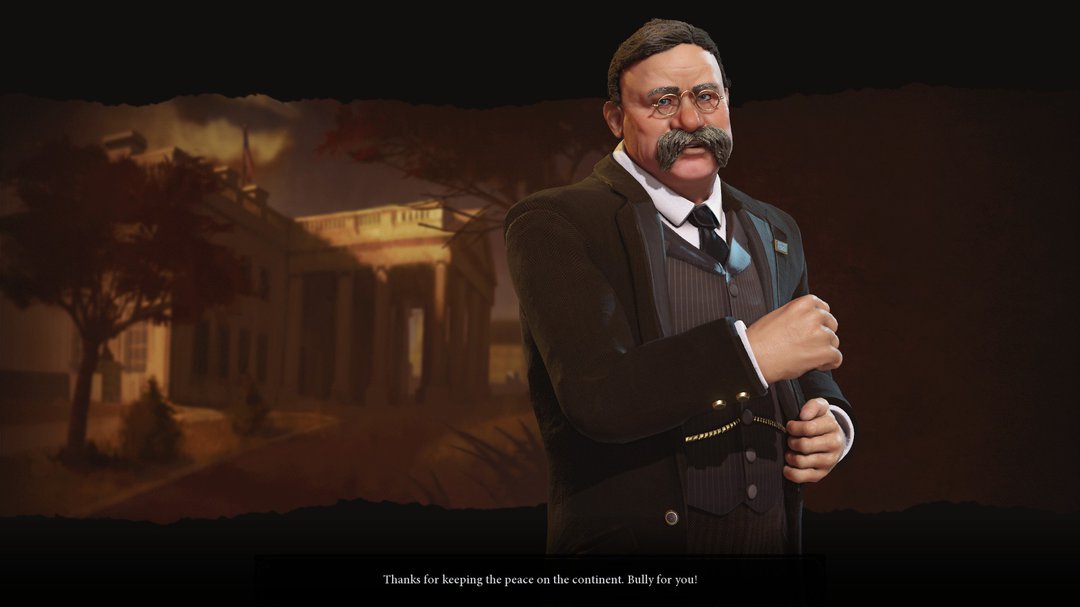
Theodore Roosevelt is probably one of my favorite presidents. For that reason, I might actually play as America again in these games.
Since the initial reveal of the game, we got more information about the overall style shift, which was that Civ 6 was going to be all about the “Age of Exploration”, trying to capture the sense of wonder in searching the map around you. Let me tell you, this gamble paid off immensely. The game is gorgeous as you search the countryside, revealing landmarks, mountains, and other cities. When your scouts keep moving, you are left with a sketched outline of what you had seen in those tiles previously, giving you a sense of being a leader staring down at a world map made in the 1600s. Watching the fog of war be pushed back and roll back in makes movement fun. Scrolling out reveals doodles and monsters on parts of the world map you haven’t searched yet. It has a style that is just as distinct as Civ 5, and works fantastically with newer, smoother graphics.
The New World Is Scary And Filled With Barbarians
With that being said, we need to talk about how Civilization VI can crush your hopes and dreams under the heel of Vandals. There is a long-standing tradition of AI controlled neutral camps, called barbarians, in the Civilization series. Based out of ragged-looking forts which pop up in areas where there is fog of war, these barbarians amble about, attacking your units, even sometimes pillaging your improved tiles or destroying your trade routes. They were a way to prod players into understanding that a military force is always required, to help keep the peace while you try and build cities.
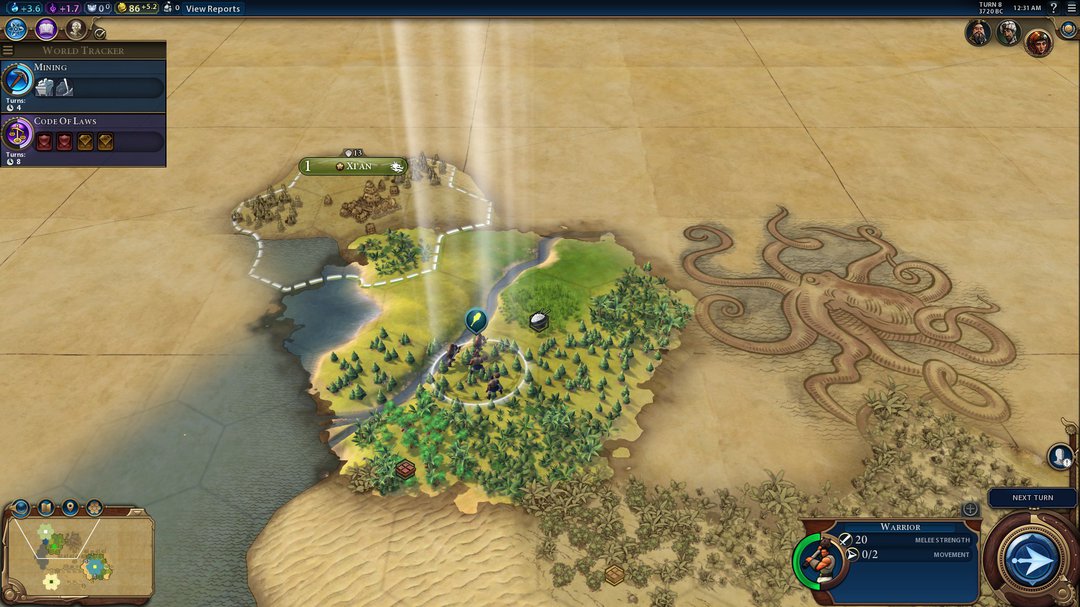
Exploring the map is now truly risky business. Again though, look at that map!
It’s safe to say that the barbarians in Civilization VI are bloodthirsty monsters in comparison to what came before them. They spawn faster and wander further from their camps, actually having scout units as you do to help them find targets. They are also much more willing to come into your area and set up a campaign of terror, pillaging and destroying your improvements and attacking your city, not just with one unit, but with several.
All of my friends which have played Civ 6 so far have mentioned they had to start a new game at least once because barbarians just became overwhelming. Most recently, my dreams of becoming a British Empire were dashed by 2000 BC as I fought a 20 turn war with one encampment of barbarians, just to turn around and see a new one had appeared just outside of my second town. This new barbarian camp now had horsemen, units I still hadn’t had a chance to research. Then again, this has nothing on what my poor friend just recently experienced:
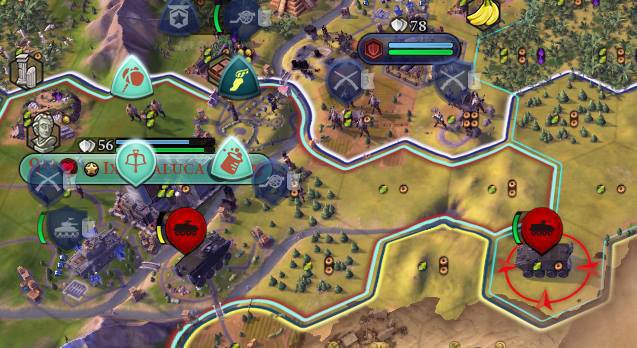
Make no mistake, Civilization VI is still fun to play in the opening turns, as you take those first steps towards an empire. However, those turns are now much more harrowing, making you work harder out the gate to establish yourself as a real nation. It forces you to adapt and play smart, rather than settling into a routine of building specific buildings in a specific order.
Building Your Empire Of Dirt
That last point about barbarians actually touches on the deliberate change that Civilization VI is trying to foster in its players: the need to change and adapt to the world around you. In previous games, it was very easy to enter into a routine of building a very specific set of buildings and wonders in a row. You would build workers and, after making sure they upgraded a few choice pieces of land, you would set on auto-improve and let them wander the countryside, slashing and burning to make room for progress.
All of that is gone now.

Now that your city bonuses are out on the map, it means that they can be pillaged specifically during times of war. It can lead to...problems.
Cities now don’t just use the land nearby for bonuses, but instead you actively lay down your city planning on those land tiles. Wonders take up space on the board, and many of the buildings you might remember from previous games are now slotted into ‘districts’. You have to build a district on the tiles around your city center, and then improve those districts with specific buildings. A campus, for example, is improved with libraries, then universities, and so on.
There are bonuses for building districts in the right place. Mountains give bonuses to campuses, while a commercial hub will do better near a river. Certain civilizations have bonuses to their districts and buildings based on if they are closer to rivers (Egypt) or are situated in the frozen tundra (Russia). Some wonders have to be built near districts, or hills, or mountains. There is planning involved to a much higher degree than previous Civilization games.
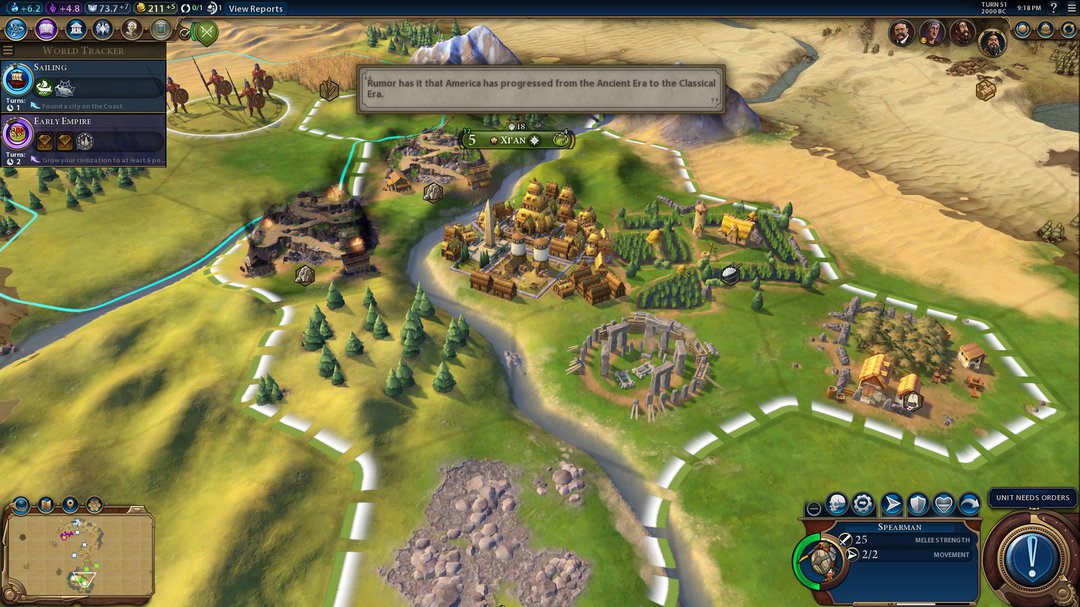
You also get to see your world wonders be built out across the landscape, which is a great touch. You can tell when an opposing nation is building one if you just look at their cities.
This theme continues onto improving land. You no longer have workers but builders, and builders have only so many uses. While they complete improvements immediately (hooray!) they vanish once they are out of juice, meaning that you want to be careful what you improve, and in what order.
There’s also a change I didn’t see coming but is very welcome: you no longer manually build roads. Instead, you watch them naturally form as you send out traders to the surrounding city-states and nations. Roads are created behind them as they wander, giving a really fun feel of expansion and growth. You no longer have to take each turn charting where workers lay down pavement, but instead watch them organically happen. Another nice touch is how when you keep moving into new ‘ages’ of technology, the bonus for moving on roads improves as they become more efficient.
The Science of Trial and Error
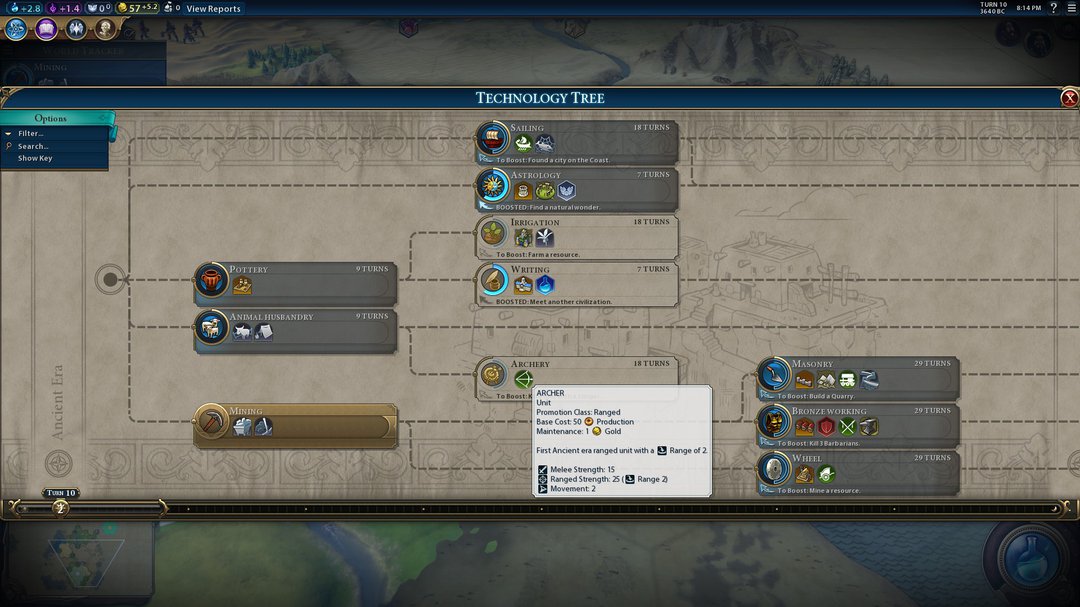
The Technology Tree is a welcome sight, but also has been majorly revamped to make it more interactive.
Whi le the city modifications are the most immediate and obvious gameplay changes, they are by no means the only ones. For me, the changes to science and the feeling of progress are VERY impressive and now help me stay interested in the game through to the end. The reason is the addition of ‘Eureka!’ moments: for most technologies, there are events that can occur which will half the amount of time that it takes to learn that technology. If you build a trader unit and start a trade route, for example, it will take you 50% less time to learn how currency works. If you have built an iron mine, you will be able to learn iron working faster than if you hadn’t.
It is a brilliant, masterful change to the tech tree. It feels so obvious and intuitive, and it rewards – yet again – adaptive gameplay. In my first game, I was Egypt, and while I stayed around rivers, I was landlocked away from the ocean. Also, for some reason, I didn’t have access to any iron or horses. To help with this, I focused on trading, which gave me bonuses towards learning better ways of making money. I was able to use this to finance a military, and then, when I got a large enough army, I got eureka bonuses towards new advancements in government and science. I was able to use my banked cash to upgrade my units into cannons and pikemen which didn’t need those resources. I then steam-rolled my horsemen-happy opponents using progress as my weapon.
The Art Of Politics And Power
Finally, we get to the civilizations themselves. As said before, the new art splashes and animations for these characters are wonderful, but the way they operate has also been overhauled as well. As usual, choosing your civilization gives you certain advantages or disadvantages, but a big change that large fans of the series will notice right off the bat is how it appears there can be more than one ruler per civilization. The Greeks start off with two: Gorgo and Pericles, and while both play with the idea of advancing culture, they do it in completely different ways. Gorgo loves to attack to gain culture, while Pericles has an approach of working with city-states. Both leaders though, for being Greece, have the Hoplite unit and a stronger theater district bonus for culture.
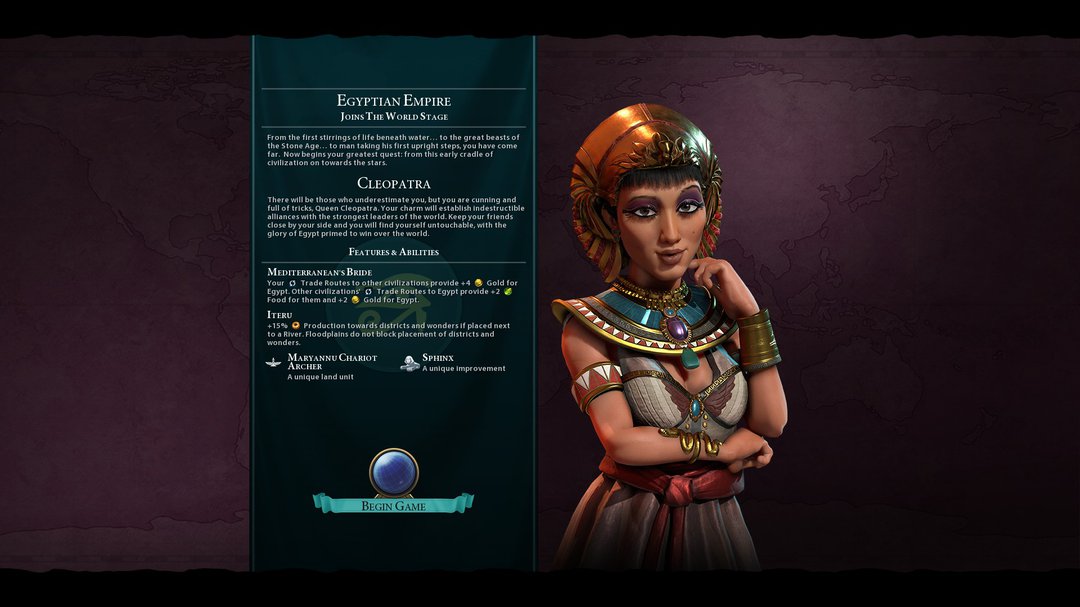
My first win came as Cleopatra, who uses rivers as her gateway to production power.
It’s exciting to see this, because that means there might be a precedent for having nations gain secondary leaders. Teddy Roosevelt is a newcomer to the series, and brings his rough riders, but how different will America play if Washington is put back in power? It adds a lot of options to a large field of twenty choices already. I love how different everyone plays: Scythia loves to mob cavalry early, while the Aztec rush consists of making free builders out of those you defeat. There is a culture for everyone, and there will be more to come as the inevitable expansions come out in later years.
It’s also with relief that I can say that the AI of these leaders is fun to play against, and Firaxis spent time to make them feel more unique. Each has two agendas: one is a standard one, set by history to match the leader it represents, and the second is hidden until you spend time trying to learn about them. I can run into a Sumeria that wants to keep the peace while building cultural marvels, or a Sumeria that keeps the peace while sending religious missionaries to all different corners of the globe. It’s a fun way to let players know some of what to expect while also making players adapt each game to a slightly different opponent.
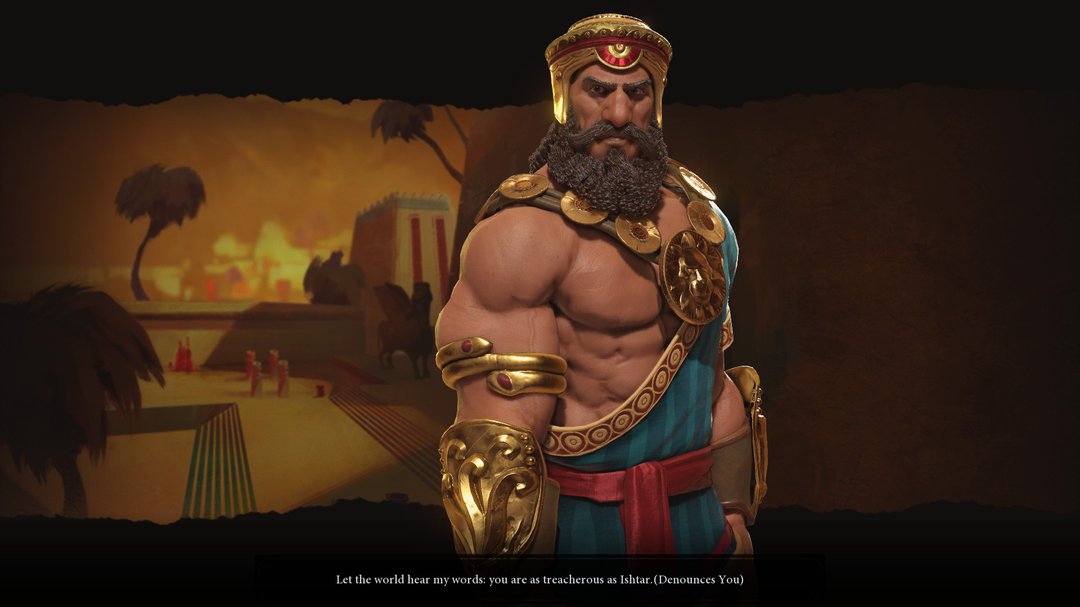
I've run into a Gilgamesh that only wanted to be friends, and another one that declared war as soon as I started taking over city-states.
There are still some quirks. In a huge map game, I’ve had people declare war on me for immediately meeting them, thanks to their agenda. Suddenly, there are three nations at war with me due to friendships and other hidden agendas. But, in about twenty turns, the leaders crawled back to me and asked for peace because I didn’t escalate the ‘war’ or ever attack. This made the nation of America like me even more, because I kept the peace. It was an odd moment, but thanks to the ‘logic’ of the game, it made sense.
It’s a new game-within-a-game. What can you do without upsetting your neighbors? Which country can you afford to piss off? A great example are the Aztecs: if you share the same resource bonuses that they have, they appreciate you as blessed, and will grow closer to you. If you land-grab to get new resources that pop up which they might not have, such as Iron, they will become angry with you, growing closer towards war in order to gain those resources for themselves. It’s honestly a fun balancing act I have in my current British game where I trade with them to keep a strong friendship going to defend my southern isles.
This turn-based titan feels more alive than ever, thanks to the tweaks that they’ve made here. It’s not perfect; the current espionage system is more frustrating than rewarding, and sometimes, the AI feels as if it’s given too much an advantage at the start of the game. With that said, Civ 6 currently feels leaps and bounds better than the previous iteration, and chatting with the leaders of other nations is still genuinely a treat.
Change Is Good, But Change Is Hard
To put it bluntly, these changes feel like a dramatic improvement, an overhaul to the basic systems that had worked for the previous five games, but were starting to feel a bit dated. The genre of 4x games has come a long way since 1991, and newcomers have worked on bettering the systems the first Civilization put in place. Endless Legend, a favorite of mine, comes to mind: it added fantastical elements, created a new way of using the map tiles, was able to work a quest system to give the game a story, and proved that the 4x game could be beautiful.
Civilization VI has done a great thing by not sticking too close to its own roots but instead learning and adapting from other game entries out there. It almost feels as if Civ has come full circle, having taken time to create the genre, sustain the genre, and now, be a massive part of its resurgence because it was willing to change along with the times.
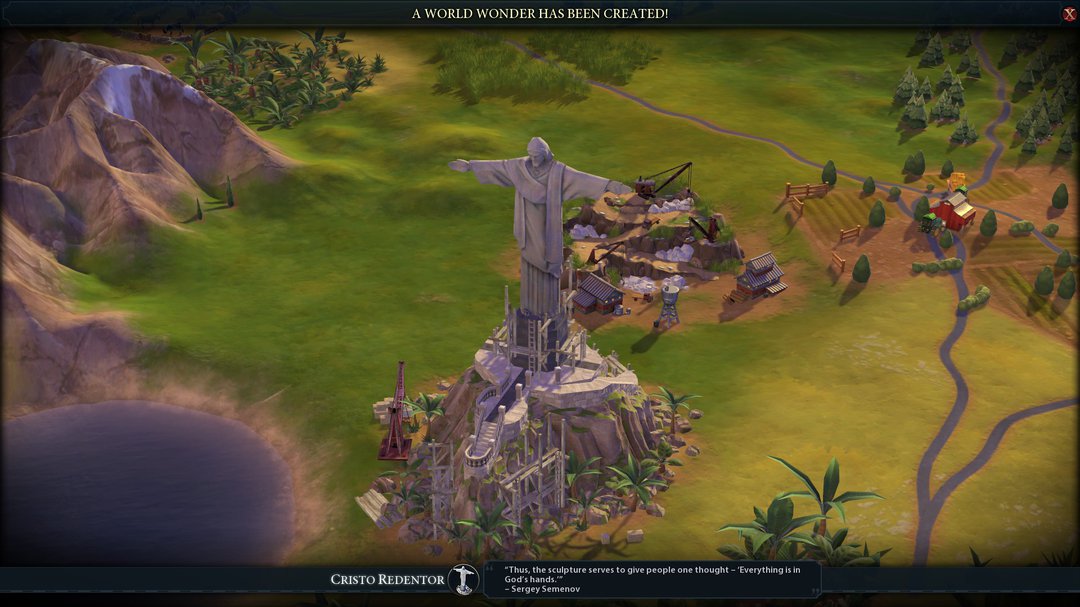
The downsides that I do see from these large changes is the alienation of some of it’s original fan base, because yes, it does feel substantially different than other iterations instead of just the newest entry. It’s also a harder game, because Firaxis was able to make the game have better, smarter AI, and between the computer opponents and the barbarians, you might find yourself being crushed early game more often than you remember in previous entries.
I’m still learning the new systems, but that’s a good thing. Civ 6 is dense with design and loving details, and I can’t wait to finally figure out how to thrive in this game, to work my way up it’s difficulty ladder. Adapt to the world around you, or perish, Civilization VI seems to announce in both form and function. As a longtime fan, I’m up to the challenge, and I hope that the changes listed above keep this game very, very popular for years to come.